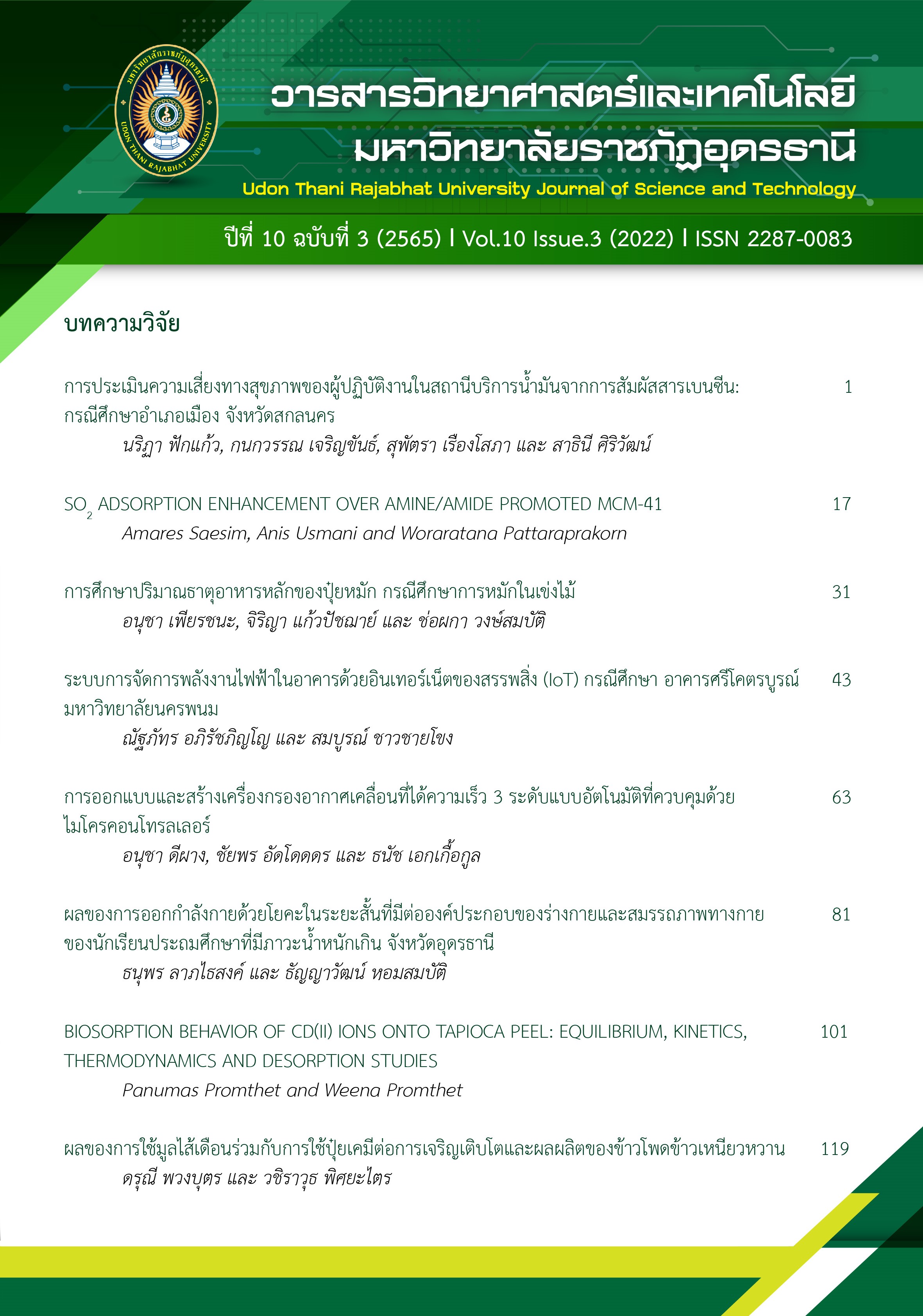BIOSORPTION BEHAVIOR OF CD(II) IONS ONTO TAPIOCA PEEL: EQUILIBRIUM, KINETICS, THERMODYNAMICS AND DESORPTION STUDIES
Main Article Content
บทคัดย่อ
The biosorption behavior of Cd(II) from aqueous solution onto industrial waste such as tapioca peel was investigated as a function of influence parameters such as contact time, solution pH, initial concentration, temperature, desorption, and regeneration. Results showed that the biosorption was relatively fast, and equilibrium was achieved within 30 min. The tapioca peel exhibited good biosorption potential at pH 5. The experiment data was described better by the Langmuir than the Freundlich isotherm model, with a maximum biosorption capacity of 36.10 mg/g. The biosorption kinetics followed a pseudo-second-order model, and the thermodynamic behaviour indicated that the Cd(II) biosorption onto tapioca peel was an endothermic process. The results of FTIR spectroscopic analysis revealed that hydroxyl and carboxyl groups on the tapioca peel surface were involved in the biosorption of Cd(II). Desorption of Cd-loaded tapioca peel was desorbed by HCl, HNO3, H2SO4, EDTA, MgCl2, and NaCl as the desorbing agents. The results showed that more than 86% desorption of Cd(II) was attained with 0.1 M HCl. The regeneration experiments showed that the biosorption capacity of tapioca peel was a total slightly reduced 6%. Meanwhile, the recovery of Cd(II) was decreased from 88.74 to 70.91% in the sixth cycle.
Article Details
เอกสารอ้างอิง
Ahmadi, H., Hafiz, S. S., Sharifi, H., Rene, N. N., Habibi, S. S., & Hussain, S. (2022). Low cost biosorbent (Melon Peel) for effective removal of Cu(II), Cd(II), and Pb(II) ions from aqueous solution. Case Studies in Chemical and Environmental Engineering, 6, 1–7.
Ajmal, M., Rao, R. A. K., Ahmad, R., & Ahmad, J. (2000). Adsorption studies on Citrus reticulata (fruit peel of orange): removal and recovery of Ni(II) from electroplating wastewater. Journal of Hazardous Materials, 79(1-2), 117–131.
Anwar, J., Shafique, U., Zaman, W., Salman, M., Dar, A., & Anwar, S. (2010). Removal of Pb(II) and Cd(II) from water by adsorption on peels of banana. Bioresource Technology, 101(6), 1752–1755.
Azouaou, N., Sadaoui, Z., Djaafri, A., & Mokaddem, H. (2010). Adsorption of cadmium from aqueous solution onto untreated coffee grounds: Equilibrium, kinetics and thermodynamics. Journal of Hazardous Materials, 184(1-3), 126–134.
Benaissa, H., & Elouchdi, M. A. (2007). Removal of copper ions from aqueous solutions by dried sunflower leaves. Chemical Engineering and Processing, 46(7), 614–622.
Dang, V. B. H., Doan, H. D., Dang–Vu, T., & Lohi, A. (2009). Equilibrium and kinetics of biosorption of cadmium (II) and copper(II) ions by wheat straw. Bioresource Technology, 100(1), 211–219.
Feng, N., Guo, X., Liang, S., Zhu, Y., & Liu, J. (2011). Biosorption of heavy metals from aqueous solutions by chemically modified orange peel. Journal of Hazardous Materials, 185(1), 49–54.
Gupta, S., Garg, D., & Kumar, A. (2022). Cadmium biosorption using Aloe. barbadensis Miller leaves waste powder treated with sodium bicarbonate. Cleaner Waste Systems, 3, 100032. DOI:10.1016/j.clwas.2022.100032.
Ho, Y. S. (2006). Review of second-order models for adsorption systems. Journal of Hazardous Materials, 136(3), 681–689.
Kwikima, M.M., Mateso, S., & Chebude, Y. (2021). Potentials of agricultural wastes as the ultimate alternative adsorbent for cadmium removal from wastewater. A review. Scientific African, 13, 1–14.
Kumar, P. S., Ramalingam, S., Kirupha, S. D., Murugesan, A., Vidhyadevi, T. & Sivanesan, S. (2011). Adsorption behavior of nickel(II) onto cashew nut shell: Equilibrium, thermodynamics, kinetics, mechanism and process design. Chemical Engineering Journal, 167(1), 122–131.
Mohammad, M., Maitra, S., Ahmad, N., Bustam, A., Sen, T. K., & Dutta, B. K. (2010). Metal ion removal from aqueous solution using physic seed hull. Journal of Hazardous Materials, 179(1), 363–372.
Saeed, A., Iqbal, M., & Holl, W. H. (2009). Kinetics, equilibrium and mechanism of Cd2+ removal from aqueous solution by mungbean husk. Journal of Hazardous Materials, 168(2-3), 1467–1475.
Saeed, A., & Iqbal, M. (2003). Bioremoval of cadmium from aqueous solution by black gram husk (Cicer arientinum). Water Research, 37(14), 3472–3480.
Saikaew, W., Kaewsarn, P., & Saikaew, W. (2009). Pomelo Peel: agricultural waste for biosorption of cadmium ions from aqueous solutions. World Academy of Science, Engineering and Technology, 56(32), 287–291.
Sari, A., Mendil, D., Tuzen, M., & Soylak, M. (2008). Biosorption of Cd(II) and Cr(III) from aqueous solution by moss (Hylocomium splendens) biomass: Equilibrium, kinetic and thermodynamic studies. Chemical Engineering Journal, 144(1), 1–9.
Volesky, B. (2007). Biosorption and me. Water Research, 41(18), 4017–4029.
Wattanakornsiri, A., Rattanawan, P., Sanmueng, T., Satchawan, S., Jamnongkan, T., & Phuengphai, P. (2022). Local fruit peel biosorbents for lead(II) and cadmium(II) ion removal from waste aqueous solution: A kinetic and equilibrium study. South African Journal of Chemical Engineering, 42, 306–317.
Zheng, L., Dang, Z., Yi, X., & Zhang, H. (2010). Equilibrium and kinetic studies of adsorption of Cd(II) from aqueous solution using modified corn stalk. Journal of Hazardous Materials, 176(1-3), 650–656.


